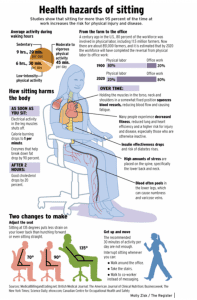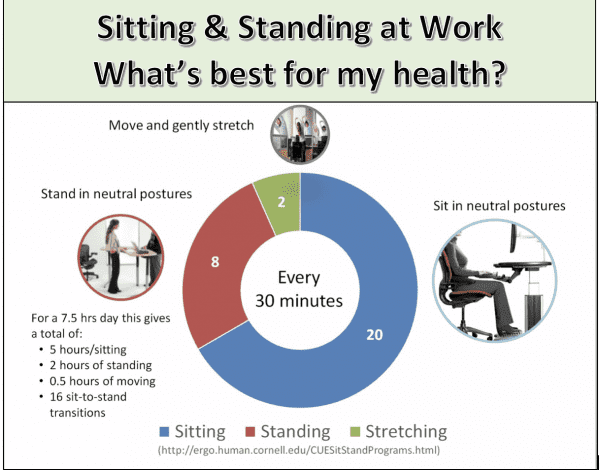THE PERILS OF SITTING
Sitting for more than a 1 hour interval has been shown to change the way we metabolise fat and glucose leading to depositing these into fat tissue rather than being burnt by our muscles.
There has been shown to be an increased risk of heart disease, metabolic disorders and musculoskeletal discomfort.
Even if you undertake regular exercise, the risk of long intervals of sitting won’t reduce these risks!
Many are now advocating standing to work because this will mean more muscle activity (about 20% more calories)
However Sitting does use less energy than standing; it also helps stabilise the body, so we usually sit to do fine motor tasks like computer work, driving, and fine detailed work.
Sitting also relieves the fatigue on muscles from standing and walking and the gives us a break from the effects of holding ourselves up against gravity.
So sitting itself is not a problem!
Its the duration of sitting that is causing most of our problems!
Ergonomists recommend sitting be broken up by periodic standing and moving. (2 minutes movement every 20 -30 minutes is good)
THE PERILS OF STANDING
Standing is more tiring. It requires approximately 20% more energy than sitting.
Prolonged standing increases the risk of varicose veins.
It reduces our fine motor skills, so the speed of keying and mouse movements reduce.
It places greater strain on the circulatory system and on the legs and feet.
Just remember, for workers who are required to stand all day we provide them with anti-fatigue mats and chairs to sit during their breaks.
Standing for long intervals is also unhealthy!
SIT TO STAND WORKSTATIONS
A common item in most workplaces today are sit to stand desks or portable sit to stand units.
Although allowing for a change of work posture, remember that both sitting and standing are sedentary activities. Undertaking either of these postures for long intervals of time can be unhealthy!
Professor Alan Hedge and his team at Cornwell University reviewed computer use when sitting and standing. They have found little evidence of any widespread benefits of sit-stand workstations, and users were observed to only stand for very short intervals (15 mins or less total / day). They also found that use of sit to stand workstations rapidly declines so that after 1 month a majority of people are again sitting most of the time.
THE BOTTOM LINE
Sit to do computer work.
About every 20 – 30 minutes MOVE for 2 minutes.
If you have a standing work option, use this as part of your 30 minute routine for posture changes. But remember standing is still sedentary.
Movement is the key!
It’s important to get blood moving through muscles; move through gravity to get the metabolism, nerves and hormones in our body a kick start.
Create greater movement variety in the way we organise our workspaces; Walk to the printer, stand for short meetings, take the stairs, walking meetings.
If you would like to learn more about this click on the following links:
- If you want to know why it is so important to move through gravity on a regular basis! And maybe slow down your ageing process!!
2. If you want to know why we should stand up and move at least every 30 minutes !
In this 2012 talk at NASA, Dr. Joan Vernikos explains how a lifestyle of frequent, low-intensity, non-exercise movement throughout the day is a great way to remain healthier.
And here is a nice poster I found online which summarises the current research guidelines:
 References:
References:
Dunstan D.W. et al(2011) Prolonged sitting: is ti a distinct coronary heart disease risk factor? Curr Opin Cardiol, Sep26(5):412-419
Hedge A., Ray E.J. (2004) Effects of an electronic height adjustable worksurface on self-assessed musculoskeletal discomfort and productivity among computer workers. Proc. HFES 48th Annual Meeting, Sept 20-24. 1091-1095


